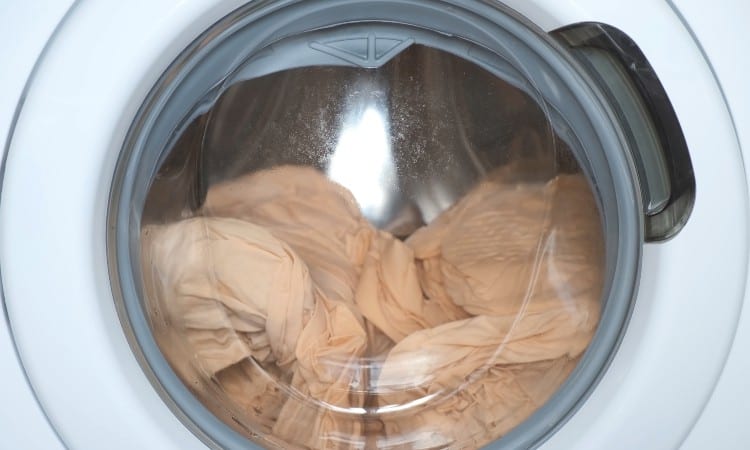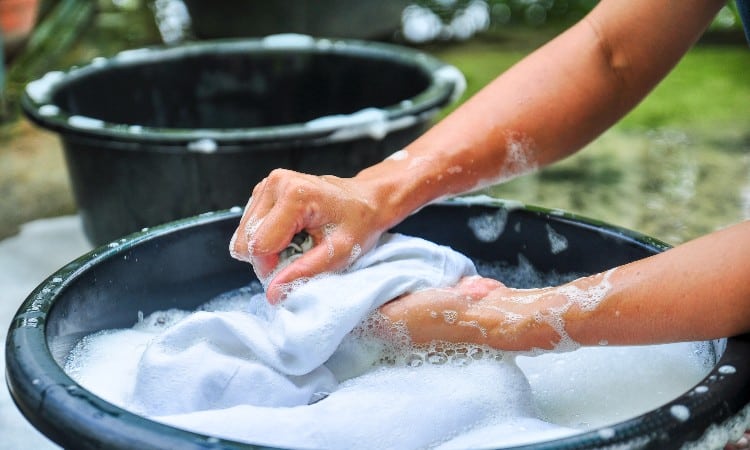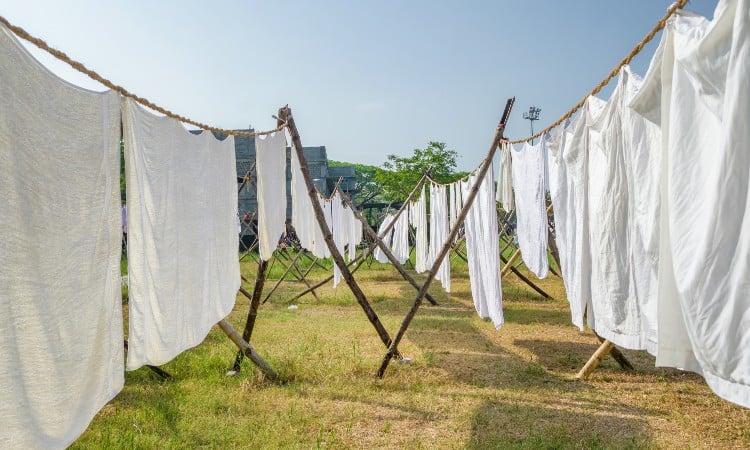If you’re like me, you have clothes in your laundry basket that have been there for a while. For me, those garments are linen. I’ve heard linen is difficult to wash. I’d like to wear my linen shirt, though. How do I wash linen clothes?
Linen clothes can be washed by hand or machine. As it’s a natural fiber, linen is prone to shrinkage and wrinkling. Because of this, linen should be washed on a low or medium heat setting. Removing the fabric from a dryer while it is still damp is best. Tailored garments or those with special trims should be dry-cleaned.
This article will show you linen isn’t as difficult to look after as you thought. Let’s take a look at how to wash linen clothing to keep it looking good for years to come. Read on for hints and tips for a successful linen wash day.

Quick Navigation
Linen Clothes: Pros and Cons
Linen is a natural fabric made of fibers from the flax plant. Its high level of breathability makes it an ideal choice for summer garments. Being both lightweight and refreshing to wear, linen wicks sweat away from your skin, helping you to stay cool.
Clothing made from linen is effortlessly stylish. Always in fashion, the look of linen has an air of timeless beauty. It has an easy-to-wear drape that offers a comfortable loose fit without being too baggy. It’s the perfect material for warm weather days at the office or a summer barbecue.
Unfortunately, linen has a reputation for being a difficult fabric to care for. This trait leads to linen clothing spending more time in the closet or the washing basket than being worn. Many people believe linen to be too difficult to care for, so it’s easier not to wear it.
The problem is that the longer linen lies forgotten at the bottom of your laundry basket, the more creased and dirty it will get. Left in your closet, it’s likely to get musty. Both scenarios mean that even if you don’t wear your linen shirt very often, you will wash it more.
Summer is a time when most of us wash our clothing more often. This is because we tend to be more active when the sun shines. Clothes can get dirty sooner than they would at cooler times of the year. Whether it’s due to perspiration, picnic stains, or residue from a muddy hike.
Being a natural plant-based material, linen doesn’t always do well in the laundry. Although it is washable, it needs a careful, delicate touch.
Washing linen clothes isn’t as hard as it sounds. All you need to do is recognize some key properties of the fabric. Let’s take a look at some of the pros and cons of linen.
Pros:
- Breathable natural fiber
- Durable fabric ideal for summer garments
- Naturally creased texture means no need to iron
- Loose-fitting drape
- Gets softer with every wash
- Can be machine or hand washed
Cons:
- Can shrink when washed
- Prone to wrinkles
- Easily crushed
- Delicate when wet
- Can’t be bleached
- Easily damaged by fabric softeners
How to Wash Linen Clothes in a Washing Machine

How you wash linen in a washing machine depends on the type of linen you have. Although most linen items are machine washable, there are some varieties of materials that are not. It’s not just because of the fiber, either. Some linen garments can’t be machine washed due to embellishments or decorative trim.
Your first step is to check the garment’s care label. This will tell you the fiber content of the fabric. The label will also let you know if your clothing has any special finish. More importantly, the care label will indicate if your linen can be washed. If it says, “dry clean only”, do not be tempted to wash it.
Dry clean-only garments tend to have an adverse reaction to water. Things like suede, silk, and, unfortunately, some linen fabric fit into this category. Any moisture coming into contact with these materials could cause irreparable damage to the garment. So if it says, “dry clean only,” take your garment to the dry cleaners.
You may find your linen’s care label has a symbol that looks like a hand in a bucket of water. It could also have a symbol that looks like a washing machine with a line through it. The first diagram means the garment is hand washable. The second indicates it cannot be machine washed.
Although your linen can be washed, you need to avoid the machine and wash the garment by hand. This could be due to the delicate nature of any decorative feature on the garment.
Once you have established that your linen can be machine washed, there are a few things you need to do before you chuck it in the drum. These are preventative measures to ensure your garment survives the wash.
Ensure you only wash linen items with other linen. Washing your linen shirt with your cotton twill pants may sound ecological, and it’s great for saving water. But, those cotton pants could be too heavy for the linen to withstand. Floating in a machine with heavier items could turn your linen shirt into dishcloths.
If you don’t have enough linen to make even a small load in a washing machine, then don’t use your machine! Hand wash your garment. You will use less water, and your garment will be safe from rougher clothes.
Fasten any buttons, snaps, or zippers. This will prevent them from snagging on the garment as it rotates inside the machine. If your linen clothing has ties, drawstrings, or beading, consider putting it in a laundry bag or play safe and hand wash it.
I’ve put together a step-by-step guide to machine-washing linen. Follow these tips and your linen garment has more chance of surviving the wash.
You will need:
- Mild laundry detergent without bleach
- Washing machine with a gentle cycle
- Commercial stain remover
- Distilled white vinegar
- Baking soda
- Bath towel
- Clothesline and pegs
Step 1
Check your garment for stains before you commit it to a washing cycle. You need to treat the stains first. Identify what caused the stain and add a commercial stain remover designed for delicate fabrics.
Alternatively, apply a pinch of baking soda and 2 drops of distilled white vinegar, and gently massage the mixture into the stained area.
Step 2
Set your machine to a gentle setting. Sometimes this is called the delicate setting. You may even have a machine that has a setting for silk. Next, add your laundry detergent. It needs to be a mild detergent free from any kind of bleach. It also needs to be just a detergent. Don’t use an all-in-one detergent and softener. Fabric softeners can damage linen fabrics.
Step 3
Next, choose the maximum water setting for your machine. You want the linen to float about freely. The more water there is, the better the chance it can do that. Because of the need for free movement, you’ll need to keep the load small.
Although you may have a few linen garments, don’t be tempted to wash them all at once. Overfilling the machine will cause them to tangle together. This will increase your risk of wrinkles and creases, which will be difficult to remove later.
The garments you select to wash together should all be closely matched in terms of weight and color to prevent tangling and the possibility of color bleeds.
Step 4
Double check your machine is set to a gentle cycle and ensure the spin is also set to gentle. Opt for no spin if your machine doesn’t have a gentle spin cycle. Linen is fragile when wet, so any rough treatment during the spin cycle could damage it.
Step 5
The next thing to check is the water temperature. This should be lukewarm. You don’t want it too hot, nor do you want it too cold. It’s best to avoid extremes in temperature. Otherwise, you could end up shrinking your linen.
Step 6
Turn your garment inside out. Add it to the drum and start the wash cycle. Remove your washing as soon as the machine stops. If you opt for a no-spin setting, the garment will be dripping wet. Don’t wring, twist, or squeeze the water out!
Grab your bath towel and roll your wet linen into it. Let the towel soak up any excess water. Once your garment has stopped dripping water but is still wet, hang it outdoors on a clothesline to air dry. Shirts and dresses should be hung from the hemline. Pants and skirts should be pegged at the waistline. It’s easier to hide peg marks that way.
How to Wash Linen Clothes by Hand

Hand washing linen clothes is time-consuming but a lot safer for the linen. Because you use your hands, the wash is less vigorous than a machine. You’ll get less chance of wrinkles and it’s easier to gauge the temperature of the water.
If the water is too hot for your hands, it will be too hot for your linen. For handwashing, you are looking at hand-hot or lukewarm. Go for the one that has the least warmth. But make sure the water isn’t cold.
As with machine washing, make sure your detergent is free from bleach and added fabric softeners. Linen is bleach intolerant and can’t survive a dip in either chlorine or peroxide-based bleach.
Fabric softeners coat the fibers in the linen. Rather than make them more supple, a softener can hinder the breathability of linen and make the material more brittle.
You will need:
- Basin, sink, or large bowl
- Mild laundry detergent without bleach
- Commercial stain remover
- Distilled white vinegar
- Baking soda
- Bath towel
- Clothesline and pegs
- Clothes hanger
Step 1
First, check your garment for stains. If there are any present, treat them with a commercial stain remover. Or mix a smidge of baking soda with 2 drops of distilled white vinegar until you get a paste. Smooth the paste onto the stain with your finger and gently massage it into the fibers. Leave it to soak into the stain for 10 minutes.
Step 2
Fill your basin or sink with enough water to cover your linen garment. You can also use a washing-up bowl but make sure it’s clean first. The water should be lukewarm or hand hot, whichever is the coolest of the two.
Step 3
Add your mild detergent to the water and mix well. You only need a small amount. No more than a level teaspoon should do it. When you mix the detergent, you should get bubbles. Add your garment and push it gently under the surface of the water. Leave it to soak for about 5 minutes. You can leave it longer if the garment is particularly dirty.
Step 4
Start to swirl the garment around in the water. Gently move it back and forth. You want to agitate the garment so the detergent can penetrate all of the fibers. Just be careful not to twist or tangle the fabric as you do so. Avoid scrubbing and wringing motions too.
Step 5
Empty the basin or bowl. Hold onto your garment as the water drains away. Replace the washing water with cool, clean water for rinsing. Fill your bowl and as it fills, you’ll see bubbles coming out of the garment and into the water. Keep changing the water until all the bubbles have gone and the water runs clear.
Step 6
Remove your garment from the bowl or basin and roll it into your bath towel. Don’t wring any excess water out of it. The bath towel will soak it up. To help it along, you can push down on your bath towel and linen roll. But don’t apply too much pressure.
Step 7
Check your linen after about 20 minutes. You should find the towel has removed much of the water and your linen is no longer dripping. At this point, you can hang it on an external clothesline to air dry. Or you can put it on a clothes hanger and hang it from a doorknob indoors.
What Temperature to Wash Linen?
The temperature you wash your linen depends on the kind of linen you have. A 100% linen may need slightly warmer water, while linen blended with synthetics may need a cooler wash.
This is why it is so important to check the care label inside your garment. The manufacturer will have carried out tests to find out the safest washing method for that particular piece of clothing. They use the care label to let you know how to look after the item.
You’ll discover if the garment is dry clean only. Or if you can wash it by machine. The label will even tell you what temperature you should wash your linen.
As a rule of thumb, linen prefers water on the cooler side. You’re looking at washing it at no higher than about 102°F, which is around 39°C. That sounds hot until you put it into perspective. A normal body temperature is approximately 98°F or 37°C.
So you are washing your linen just a little higher than your body temperature. This is why lukewarm water is also known as hand hot. If it’s less than your body temperature, it will feel cool against your skin. Above your temperature and you’ll feel a little heat. Too much heat, you’ll burn your hands.
Too hot for your hands means way too hot for linen. So trust your skin and how the water feels next to it. If your hands feel like they are burning, add some cold water before washing your linen. The water should feel warm but comfortable. A temperature just right for your hands is the right temperature to wash your linen.
Washing machines are less easy to gauge. They don’t all have handy dials saying the temperature they wash at in degrees. Some only have a cold, cool, warm, or hot setting. If your machine doesn’t have a wash setting saying the exact temperature, go for cool.
Do You Have to Dry Clean Linen?
No, you don’t have to dry clean linen. It is perfectly safe to wash linen either by hand or machine. However, it does depend on what linen you are working with. Some linens are dry clean only.
There is a reason for the difference in care needed for different linens. It’s down to the fiber content and the finish of the garment. Some trims and decorative features don’t stand up to moisture. Meaning the whole garment has to be dry cleaned.
Dry cleaning isn’t all bad. It does incur a cost in the way of a cleaning bill. But, there are some really good benefits. The main one is fewer wrinkles. Linen is a fabric known for its tendency to wrinkle and crease. Adding water to the mix just adds to the likelihood of increased wrinkling.
Take it to a dry cleaner and it will be professionally cleaned without getting it near water. Not only will this alleviate the wrinkle issue, but it will also prevent your garment from shrinking. Sometimes having the piece of mind that your garment will survive a clean is worth every penny a trip to the cleaners will cost you.
Check your care label before deciding to wash or dry clean your garment. Everything you need to know will be on the label and help ensure you care for your clothing correctly.
How to Dry Linen Clothes

You can dry your linen clothing naturally or by using a dryer. There is a word of caution attached to that statement, though. Dryers are notorious for giving off heat. That’s essentially how they dry clothes. For most garments, heat is fine. Some garments relish the warmth and come out of the dryer super soft.
Linen clothing is not one of those garments. Heat and linen are not a great combination, because heat makes linen shrink.
If you want to dry your linen in a dryer:
- Make sure it is set on the lowest heat setting possible.
- Keep an eye on it and open the door occasionally to see how it’s doing.
- Don’t let the linen dry completely in the dryer.
Doing so will set creases into the fabric and speed up the shrinking process.
When you use your dryer, your linen should be the only garment. It’s OK to dry linen with linen, but don’t be tempted to put other garments in there. Especially not if they have zippers, buckles, or buttons. The tumbling motion will cause the garments to tangle and your linen could end up torn.
You want to remove your garment while it is still damp too. Shake it out a bit, and then hang it up to dry naturally. A clothes hanger or pegging it to an external clothesline is a great way to finish drying your linen. As an added bonus, your linen will smell fresher with a hint of the great outdoors.
The best and safest way to dry your linen clothes is naturally. However, we live in the 21st century and time isn’t always on our side. A quick tumble in a dryer will speed things up. But keep drying sessions to a minimum and never dry your linen with anything else.
Best Detergent for Linen Clothes
 The best laundry detergent for linen clothes is a mild one suitable for natural fibers. Woolite is a good choice. It has been specially formulated to protect fibers from shrinking, stretching, and fading. Free from bleach, it’s safe to use on linen and other delicate fibers like wool and silk.
The best laundry detergent for linen clothes is a mild one suitable for natural fibers. Woolite is a good choice. It has been specially formulated to protect fibers from shrinking, stretching, and fading. Free from bleach, it’s safe to use on linen and other delicate fibers like wool and silk.
Woolite is a great detergent for all your wash. Woolite Everyday helps remove all the debris and dirt you can pick up throughout the day. Not just from your linen garments but also from your jeans, your sportswear, and your delicate underwear.
If Woolite is not available where you are, you can use regular detergent. There are a couple of things to watch out for, though. Make sure the detergent is mild and free from any kind of bleach. That includes chlorine bleach and peroxide.
You should also keep your linen away from fabric softeners or conditioners. That means you should also steer clear of any laundry detergent that has added fabric softening properties.
Conclusion
Linen clothes are cool to wear and easy to care for. Wash them by hand or machine. It’s up to you. But make sure to use lukewarm water and a mild, bleach-free detergent.
Drying your garment is simple too. Use a cool dryer until the garment is damp, then air dry. Or just air dry it on a clothesline.
Do you own any linen garments? How do you care for them? Has this article encouraged you to add linen to your wardrobe? Let me know in the comments.